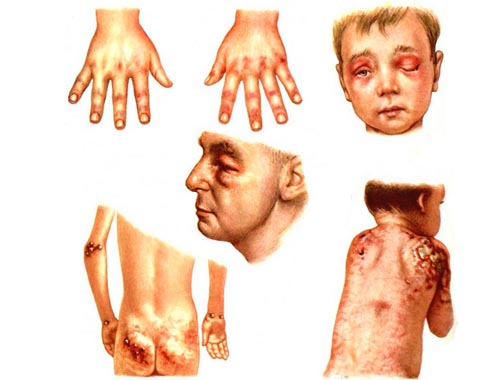Myositis, polymyositis, dermatomyositis

Published: 18 Jun 2025
ICD9: 710.3 ICD10: M33.90 ICD11: 4A41.0
Myositis, polymyositis, and dermatomyositis are a group of rare inflammatory diseases that affect the muscles.
They cause muscle weakness, pain, and fatigue. Here's a breakdown of each:
1. Myositis:
![]() This is a general term meaning inflammation of the muscles. It's not a specific disease, but rather a description of a symptom. Many different conditions can cause myositis.
This is a general term meaning inflammation of the muscles. It's not a specific disease, but rather a description of a symptom. Many different conditions can cause myositis.
2. Polymyositis (PM):
![]() What it is: A chronic inflammatory disease that causes muscle weakness, mainly affecting the muscles closest to the trunk of the body (shoulders, hips, thighs, upper arms).
What it is: A chronic inflammatory disease that causes muscle weakness, mainly affecting the muscles closest to the trunk of the body (shoulders, hips, thighs, upper arms).
![]() Symptoms:
Symptoms:![]()

![]() Progressive muscle weakness (difficulty climbing stairs, lifting arms, rising from a chair)
Progressive muscle weakness (difficulty climbing stairs, lifting arms, rising from a chair)![]()

![]() Muscle pain and tenderness (sometimes)
Muscle pain and tenderness (sometimes)![]()

![]() Fatigue
Fatigue![]()

![]() Difficulty swallowing (dysphagia)
Difficulty swallowing (dysphagia)![]()

![]() Difficulty breathing (if respiratory muscles are affected)
Difficulty breathing (if respiratory muscles are affected)
![]() Cause: The exact cause is unknown, but it's believed to be an autoimmune disorder, where the body's immune system mistakenly attacks its own muscle tissue.
Cause: The exact cause is unknown, but it's believed to be an autoimmune disorder, where the body's immune system mistakenly attacks its own muscle tissue.
![]() Diagnosis:
Diagnosis:![]()

![]() Physical exam and medical history
Physical exam and medical history![]()

![]() Blood tests (elevated muscle enzymes like creatine kinase (CK))
Blood tests (elevated muscle enzymes like creatine kinase (CK))![]()

![]() Electromyography (EMG) - measures electrical activity in muscles
Electromyography (EMG) - measures electrical activity in muscles![]()

![]() Muscle biopsy - examination of a small piece of muscle tissue
Muscle biopsy - examination of a small piece of muscle tissue
![]() Treatment:
Treatment:![]()

![]() Corticosteroids (like prednisone) - to reduce inflammation
Corticosteroids (like prednisone) - to reduce inflammation![]()

![]() Immunosuppressants (like methotrexate, azathioprine) - to suppress the immune system
Immunosuppressants (like methotrexate, azathioprine) - to suppress the immune system![]()

![]() Physical therapy - to maintain muscle strength and function
Physical therapy - to maintain muscle strength and function
3. Dermatomyositis (DM):
![]() What it is: A type of myositis that also involves a characteristic skin rash in addition to muscle inflammation and weakness.
What it is: A type of myositis that also involves a characteristic skin rash in addition to muscle inflammation and weakness.
![]() Symptoms: Includes all the symptoms of polymyositis *plus* a distinctive rash.
Symptoms: Includes all the symptoms of polymyositis *plus* a distinctive rash.![]()

![]() Rash:
Rash:![]()

![]() Heliotrope rash: A purplish or bluish rash around the eyelids.
Heliotrope rash: A purplish or bluish rash around the eyelids.![]()

![]() Gottron's papules: Raised, scaly, reddish or purplish bumps on the knuckles, elbows, and knees.
Gottron's papules: Raised, scaly, reddish or purplish bumps on the knuckles, elbows, and knees.![]()

![]() Other skin manifestations: Redness or scaling on the face, neck, upper chest ("V-neck sign"), and back ("shawl sign").
Other skin manifestations: Redness or scaling on the face, neck, upper chest ("V-neck sign"), and back ("shawl sign").![]()

![]() Cuticles can be inflamed or thickened
Cuticles can be inflamed or thickened
![]() Cause: Similar to polymyositis, it's believed to be an autoimmune disorder. There is also a higher association with certain cancers in older adults with dermatomyositis.
Cause: Similar to polymyositis, it's believed to be an autoimmune disorder. There is also a higher association with certain cancers in older adults with dermatomyositis.
![]() Diagnosis: Similar to polymyositis, but with visual assessment of the rash.
Diagnosis: Similar to polymyositis, but with visual assessment of the rash.
![]() Treatment:
Treatment:![]()

![]() Similar to polymyositis (corticosteroids, immunosuppressants)
Similar to polymyositis (corticosteroids, immunosuppressants)![]()

![]() Topical corticosteroids or other skin treatments for the rash
Topical corticosteroids or other skin treatments for the rash![]()

![]() Sun protection (sunscreen, protective clothing) to minimize rash flares.
Sun protection (sunscreen, protective clothing) to minimize rash flares.
Key Differences and Considerations:
![]() Skin involvement: The presence of the characteristic rash is the main difference between polymyositis and dermatomyositis. Polymyositis does *not* have a rash.
Skin involvement: The presence of the characteristic rash is the main difference between polymyositis and dermatomyositis. Polymyositis does *not* have a rash.
![]() Cancer risk: Dermatomyositis has a slightly higher association with underlying cancers, particularly in older adults. Therefore, cancer screening may be recommended.
Cancer risk: Dermatomyositis has a slightly higher association with underlying cancers, particularly in older adults. Therefore, cancer screening may be recommended.
![]() Age of onset: Polymyositis typically affects adults, while dermatomyositis can affect both adults and children.
Age of onset: Polymyositis typically affects adults, while dermatomyositis can affect both adults and children.
![]() Other organs: In some cases, polymyositis and dermatomyositis can affect other organs, such as the lungs, heart, and joints.
Other organs: In some cases, polymyositis and dermatomyositis can affect other organs, such as the lungs, heart, and joints.
Important points to remember:
![]() These are rare conditions.
These are rare conditions.
![]() Early diagnosis and treatment are important to manage symptoms and prevent complications.
Early diagnosis and treatment are important to manage symptoms and prevent complications.
![]() Treatment is often long-term and requires ongoing monitoring.
Treatment is often long-term and requires ongoing monitoring.
![]() The severity of the disease can vary from person to person.
The severity of the disease can vary from person to person.
Disclaimer: This information is for general knowledge and educational purposes only, and does not constitute medical advice. It is essential to consult with a qualified healthcare professional for any health concerns or before making any decisions related to your health or treatment. They can properly diagnose your condition and recommend the most appropriate course of action.